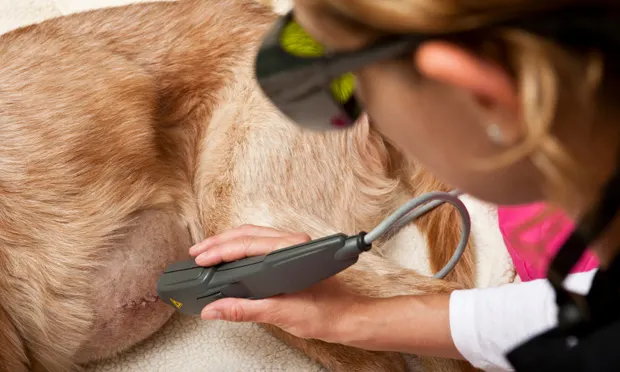Creating a Successful Laser Therapy Program

Veterinary laser therapy offers the opportunity to add a new service to benefit your patients and practice. Some practices may already have a laser that is collecting dust, whereas others may have successful pain management programs but need another component to complement pain management services. Still others may be considering laser therapy equipment but have not yet made the investment. The following offers ways to successfully add laser therapy to patient-care programs.
Buy-In
Client and team buy-in is imperative. A successful pain management program that covers every patient—from those receiving wellness care, to hospitalized patients, to those undergoing surgery—is the foundation.
When starting a pain management program, it is necessary to incorporate a patient pain scale used consistently throughout the practice. Every patient should be evaluated for pain and assigned both an acute and chronic pain score, and each score should have defined treatment recommendations. Everyone involved in patient care should know these scores, what they mean, and their treatment. Forms used in practice should include pain scores to ensure they are recorded after every evaluation.
Practices should also educate clients about their pet’s pain and the meaning of his or her pain score. Help clients understand their pet’s pain scores with pictures, diagrams, and examples, just as with weight or body condition scores. Teaching clients what to watch for and asking open-ended questions about changes in their pet’s behavior can help them be more aware about pain.
Show clients how laser therapy can improve their pet’s quality-of-life. Select several patients that could benefit from laser treatment by choosing different cases that demonstrate the laser’s extensive use (see Laser Therapy Indications). Consider providing laser therapy in exchange for client testimonials with photos of the treated pet.
To ensure team buy-in, all team members should be trained on the equipment’s features and benefits. Then, a small team of those who will administer the therapy should be trained intensively. Selecting team members that are most passionate about this service can help generate excitement. Consider starting with just one individual and build the program slowly; a strong foundation may attract others. Offering the service free to your team’s pets for a set period can also help achieve their buy-in.
Marketing
The laser manufacturer and/or distributor can likely help with some marketing; however, their tools and programs should just be the start, and an ongoing plan should be designed to ensure the team and clients are always aware of laser therapy services that are available.
The most cost-effective marketing tool is a simple, repetitive plan that targets the practice’s existing client base. The plan could include:
A schedule of online marketing pieces―including emails, blog posts, and social media.
Client education visuals, such as brochures, bulletin boards, and posters.
Pain assessment and education during each patient examination, followed by a discussion with each client about his or her pet’s pain.
Take-home pain management plans for clients who have pets with chronic pain.
Outside the practice, the marketing budget should be spent wisely. A plan could include:
Regularly updating the practice website about available laser therapy treatments for pain management.
Asking outside marketing representatives to help spread the word within the practice’s current budget or with a minimal investment.
A direct mailing to animal owners in the community.
Renaming the practice to include mention of a laser center.
Setting up a referral program with other area practices that do not provide the service.
Integration
Next, integrate the laser therapy program into other services already provided. Veterinarians will prescribe the initial treatment program, so consider a higher charge for initial treatment with subsequent follow-up treatments— performed by support staff—at a lower price. When setting fees, always take into consideration that multiple team members may be needed and multiple treatments may be necessary. Be mindful of general clientele income and be aware of any competitors’ charges. New service codes should be created for individual and package treatments.
Integrate therapy laser treatments into current care plans—such as wellness check-ups, surgery, postoperative care, and rehabilitation services. Always make sure that any extra charges are listed separately and discussed with the client.
Change Your View
It is important to realize that just purchasing the laser and marketing the extra service to existing clients is not enough. Thoughtfully integrating the therapy laser into current treatment plans as an additional service can help both your patients and practice thrive.
This article originally appeared in the September 2013 web issue of Veterinary Team Brief.